�
2
3
�
Cover image : “World at Night” by Karie Krocker, http://earthobservatory.nasa.gov.
Esri Press, 380 New York Street, Redlands, California 92373-8100
Copyright © 2017 Esri
All rights reserved. First edition 2017
Printed in the United States of America
21 20 19 18 17 1 2 3 4 5 6 7 8 9 10
Library of Congress has cataloged the print edition as follows:
Names: Gorr, Wilpen L., author. | Kurland, Kristen Seamens, 1966- author.
Title: GIS tutorial 1 for ArcGIS Pro : a platform workbook / Wilpen L. Gorr, Kristen S. Kurland.
Description: Redlands, California : Esri Press, [2017] | Includes index. | Identifiers: LCCN 2017021478 (print) | LCCN 2017036777 (ebook)
| ISBN 9781589484931 (e-book) | ISBN 9781589484665 (trade paper)
Subjects: LCSH: ArcGIS. | Geographic information systems--Handbooks, manuals, etc. | Spatial analysis (Statistics)
Classification: LCC G70.212 (ebook) | LCC G70.212 .G73 2017 (print) | DDC 910.285/53--dc23
LC record available at https://urldefense.proofpoint.com/v2/url?u=https-3A__lccn.loc.gov_2017021478&d=DwIFAg&c=n6-
cguzQvX_tUIrZOS_4Og&r=RhmcbAxStnbJpr06ef1onNDeVX-gjVopdqeQ8i7DbIY&m=q8beDsc21SAC8K6U0BwYl1RlCUj0W2F-
rIF6EM7TXQc&s=pcyAlj4KR0sUQyAjNpTWFr6QZjhvg1tpH1UE0vEOD7g&e=154655
The information contained in this document is the exclusive property of Esri unless otherwise noted. This work is protected under United
States copyright law and the copyright laws of the given countries of origin and applicable international laws, treaties, and/or conventions. No
part of this work may be reproduced or transmitted in any form or by any means, electronic or mechanical, including photocopying or recording,
or by any information storage or retrieval system, except as expressly permitted in writing by Esri. All requests should be sent to Attention:
Contracts and Legal Services Manager, Esri, 380 New York Street, Redlands, California 92373-8100, USA.
The information contained in this document is subject to change without notice.
US Government Restricted/Limited Rights: Any software, documentation, and/or data delivered hereunder is subject to the terms of the
License Agreement. The commercial license rights in the License Agreement strictly govern Licensee’s use, reproduction, or disclosure of the
software, data, and documentation. In no event shall the US Government acquire greater than RESTRICTED/LIMITED RIGHTS. At a
minimum, use, duplication, or disclosure by the US Government is subject to restrictions as set forth in FAR §52.227-14 Alternates I, II, and
III (DEC 2007); FAR §52.227-19(b) (DEC 2007) and/ or FAR §12.211/12.212 (Commercial Technical Data/Computer Software); and
DFARS §252.227-7015 (DEC 2011) (Technical Data–Commercial Items) and/or DFARS §227.7202 (Commercial Computer Software and
Commercial Computer Software Documentation), as applicable. Contractor/Manufacturer is Esri, 380 New York Street, Redlands, CA 92373-
8100, USA.
@esri.com, 3D Analyst, ACORN, Address Coder, ADF, AML, ArcAtlas, ArcCAD, ArcCatalog, ArcCOGO, ArcData, ArcDoc, ArcEdit,
ArcEditor, ArcEurope, ArcExplorer, ArcExpress, ArcGIS, arcgis.com, ArcGlobe, ArcGrid, ArcIMS, ARC/INFO, ArcInfo, ArcInfo
Librarian, ArcLessons, ArcLocation, ArcLogistics, ArcMap, ArcNetwork, ArcNews, ArcObjects, ArcOpen, ArcPad, ArcPlot, ArcPress, ArcPy,
ArcReader, ArcScan, ArcScene, ArcSchool, ArcScripts, ArcSDE, ArcSdl, ArcSketch, ArcStorm, ArcSurvey, ArcTIN, ArcToolbox, ArcTools,
ArcUSA, ArcUser, ArcView, ArcVoyager, ArcWatch, ArcWeb, ArcWorld, ArcXML, Atlas GIS, AtlasWare, Avenue, BAO, Business Analyst,
Business Analyst Online, BusinessMAP, CityEngine, Community-Info, Database Integrator, DBI Kit, EDN, Esri, esri.com, Esri—Team
GIS, Esri—The GIS Company, Esri—The GIS People, Esri—The GIS Software Leader, FormEdit, GeoCollector, Geographic Design System,
Geography Matters, Geography Network, geographynetwork.com, Geoloqi, Geotrigger, GIS by Esri, gis.com, GISData Server, GIS Day,
gisday.com, GIS for Everyone, JTX, MapIt, Maplex, MapObjects, MapStudio, ModelBuilder, MOLE, MPS—Atlas, PLTS, Rent-a-Tech,
SDE, SML, Sourcebook·America, SpatiaLABS, Spatial Database Engine, StreetMap, Tapestry, the ARC/INFO logo, the ArcGIS Explorer
logo, the ArcGIS logo, the ArcPad logo, the Esri globe logo, the Esri Press logo, The Geographic Advantage, The Geographic Approach, the
GIS Day logo, the MapIt logo, The World’s Leading Desktop GIS, Water Writes, and Your Personal Geographic Information System are
trademarks, service marks, or registered marks of Esri in the United States, the European Community, or certain other jurisdictions.
CityEngine is a registered trademark of Procedural AG and is distributed under license by Esri. Other companies and products or services
mentioned herein may be trademarks, service marks, or registered marks of their respective mark owners.
Ask for Esri Press titles at your local bookstore or order by calling 800-447-9778, or shop online at esri.com/esripress. Outside the United
4
�
States, contact your local Esri distributor or shop online at eurospanbookstore.com/esri.
Esri Press titles are distributed to the trade by the following:
In North America:
Ingram Publisher Services
Toll-free telephone: 800-648-3104
Toll-free fax: 800-838-1149
E-mail: customerservice@ingrampublisherservices.com United Kingdom
In the United Kingdom, Europe, Middle East and Africa, Asia, and Australia:
Eurospan Group
3 Henrietta Street
London WC2E 8LU Fax: 44(0) 1767 601640
Telephone: 44(0) 1767 604972
E-mail: eurospan@turpin-distribution.com
5
�
Contents
Preface
Acknowledgments
Part 1: Using, making, and sharing maps
Chapter 1: The ArcGIS platform
Chapter 2: Map design
Chapter 3: Map outputs for GIS projects
Part 2: Working with spatial data
Chapter 4: File geodatabases
Chapter 5: Spatial data
Chapter 6: Geoprocessing
Chapter 7: Digitizing
Chapter 8: Geocoding
Part 3: Applying advanced GIS technologies
Chapter 9: Spatial analysis
Chapter 10: Raster GIS
Chapter 11: 3D GIS
Part 4: Managing operational systems with GIS
Chapter 12: Operations management with GIS: Graffiti Mapping System
Chapter 13: Operations management with GIS: Graffiti Removal System
Data source credits
6
�
Preface
Welcome to GIS Tutorial 1 for ArcGIS® Pro. This step-by-step workbook focuses on ArcGIS Pro but also
covers ArcGIS OnlineSM and some of its major apps for mobile computing, including Esri® Story Maps,
Operations Dashboard for ArcGIS®, and Collector for ArcGIS®.
ArcGIS Pro is Esri’s next-generation, 64-bit desktop software with an intuitive user interface for creating,
using, and analyzing professional 2D and 3D maps. ArcGIS Pro’s tasks, ModelBuilder models, and apps also
allow you to build operational systems that help organizations use GIS on a daily basis. You create tasks to
guide complex workflows, and you build models to automate multiple geoprocessing steps, all without
computer coding. The apps provide GIS results and capabilities to all who need them.
ArcGIS Online is a complete cloud-based mapping platform for making, using, analyzing, and sharing
maps. You can easily publish maps authored in ArcGIS Pro to ArcGIS Online and integrate them with maps
from Esri’s Living Atlas of the World, available in ArcGIS Online. The Living Atlas, curated by Esri, is the
world’s foremost collection of ready-to-use maps. With your finished maps stored in ArcGIS Online, they are
easily shared in ArcGIS Online apps.
Esri Story Map apps allow you to incorporate text, charts, and other content with interactive maps to tell a
story or to make a report on a GIS project. Want to see the story map that you’ll build in chapter 3? Open
http://arcg.is/2n17PX0 in your browser on your computer, tablet, or smartphone (look for an information
button on your tablet or smartphone to see nonmap content). Operations Dashboard monitors an
organization’s demands for services and performance with maps, statistics, charts, lists, and queries. Collector
allows for collecting and updating spatial and attribute data in the field using mobile computing devices.
This book is a complete learning system for GIS, including features we have evolved in more than 25 years
of teaching GIS using Esri products and writing tutorials. Our books are used successfully by students in
classes as well as by self-learners. We’ve taught high school students, in-career professionals, undergraduate
students, master’s students, PhD students, and distance-learning students across many disciplines. We teach
using a combination of lectures and lab sessions, and we always include student-designed GIS projects as a
final requirement in our courses. Our interactions with students are important sources of ideas and feedback
for our books.
This book includes wide-ranging real-world data and GIS applications that require integration of different
GIS processing steps and workflows to solve realistic problems. This book addresses many topical issues,
including these examples:
7
�
Accessing urgent-care health clinics by low-income populations
Finding employment prospects in arts fields across US cities, including the size of arts communities,
average incomes, and cost of living
3D modeling of city buildings using lidar data for city planning
Building a system for scheduling and routing of graffiti removal in a city
Location analyses
Placing defibrillators outdoors to resuscitate heart attack victims in a city
Locating farmers markets as part of a city’s solution to its “food desert” problem
Digitizing a university campus’s buildings and walkways from satellite images for use in master
planning
Data mining crime patterns in a city for insights into criminal behavior
The book presents essential concepts at the start of each chapter or at the start of tutorials. Sections on
concepts are separated from tutorial steps to ensure continuous, hands-on computer work.
Short chunks of step-by-step tutorials are illustrated with screen captures and brief comments when
helpful. We try to limit these short sections to a maximum of 10 steps each to help you stay focused. These
small chunks facilitate learning and retention, and provide a sense of accomplishment.
In Your Turn assignments within tutorials, you will repeat steps just taken but in slightly modified ways.
These short assignments help you begin to internalize steps and workflows.
On the book’s web resource page (esri.com/gist1arcgispro), you will find related assignments to help you
apply each chapter’s concepts and workflows independently. The tutorial steps expose you to GIS and serve as
a reference, while the assignments provide additional resources for more in-depth learning. In the classroom,
instructors will likely ask you to turn in assignments for grading.
The four parts of this book are organized in a sequence that best motivates and facilitates your learning of
GIS.
In part 1, “Using, making, and sharing maps,” the first three chapters of the book introduce you to the
ArcGIS user interface through finished maps. You will symbolize a range of map types using cartographic
principles and build map layouts and Esri Story Maps to present your results.
The five chapters in part 2, “Working with spatial data,” prepare you for finding and understanding spatial
data. You will store and process spatial data in file geodatabases, geoprocess spatial data for mapping and
analysis, digitize your own spatial data, and geocode tabular data for mapping.
The three chapters in part 3, “Applying advanced GIS technologies,” focus on analyzing spatial data and
maps to solve problems. You will apply a number of unique GIS methods for analyzing spatial relationships,
including buffers, service areas, facility location, and data clustering. You will use raster GIS (which works
with satellite images and other continuous data) to analyze demand for services. Part 3 concludes with an
exploration of 3D GIS to model urban redevelopment projects.
In part 4, “Managing operational systems with GIS,” the final two chapters of the book provide hands-on
experience in building operations management systems. In chapter 12, you create tasks and a ModelBuilder
model to prepare and publish weekly graffiti location data on a map. You also create an operation view using
8
�
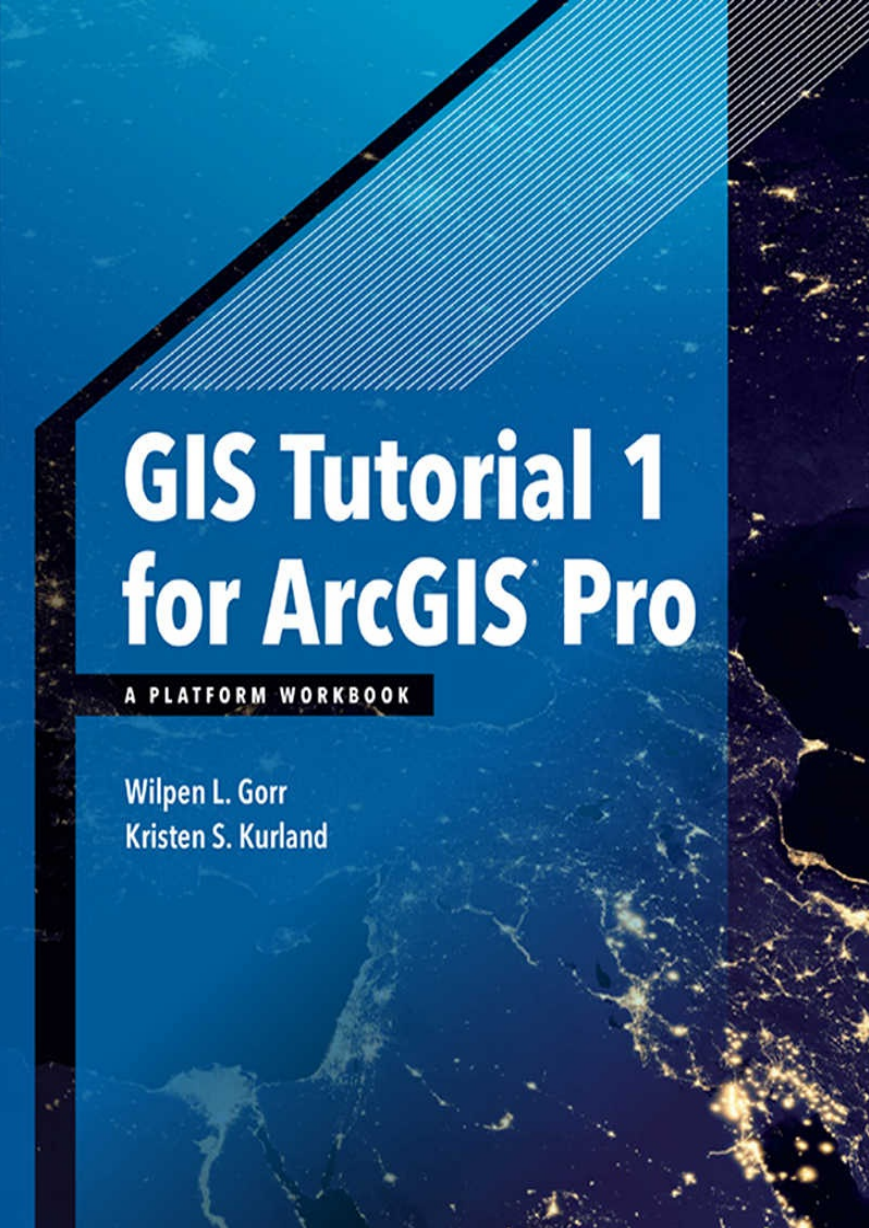


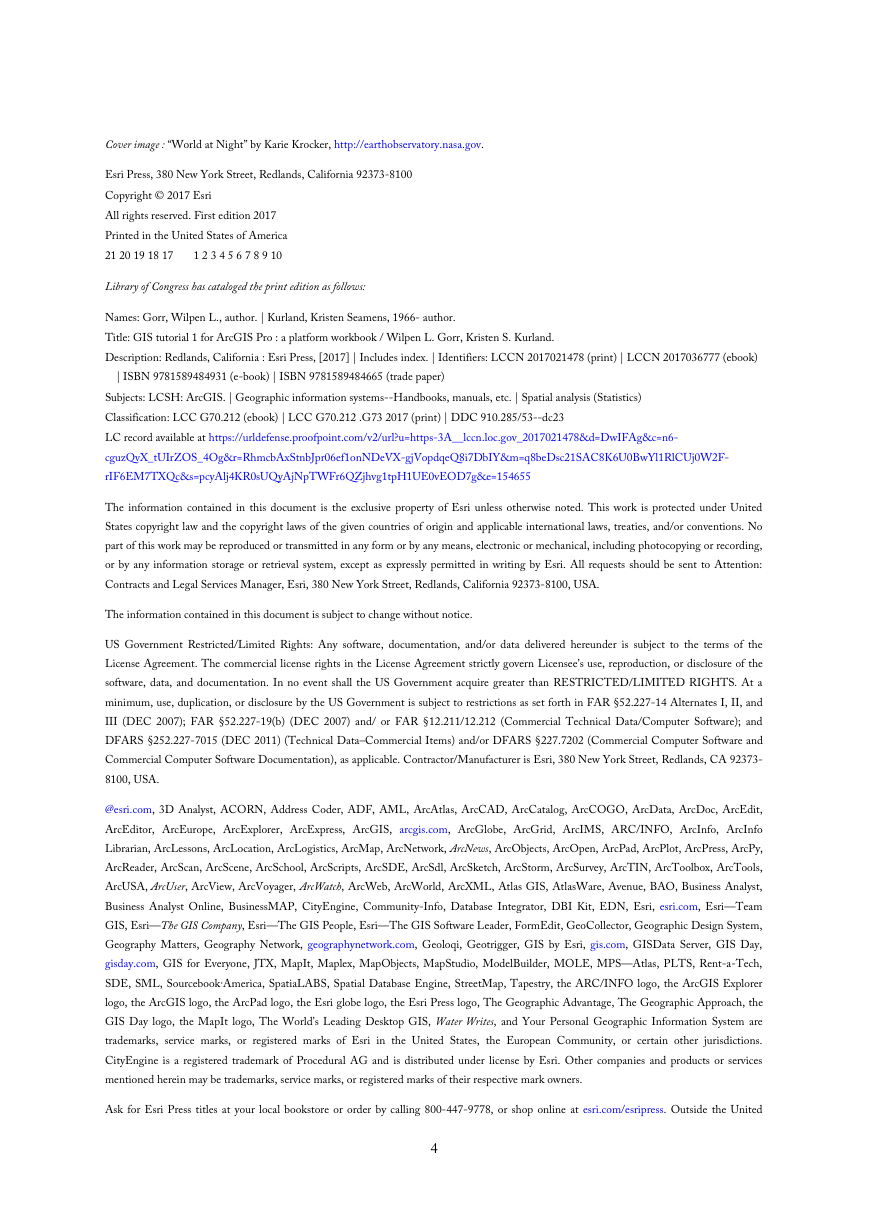

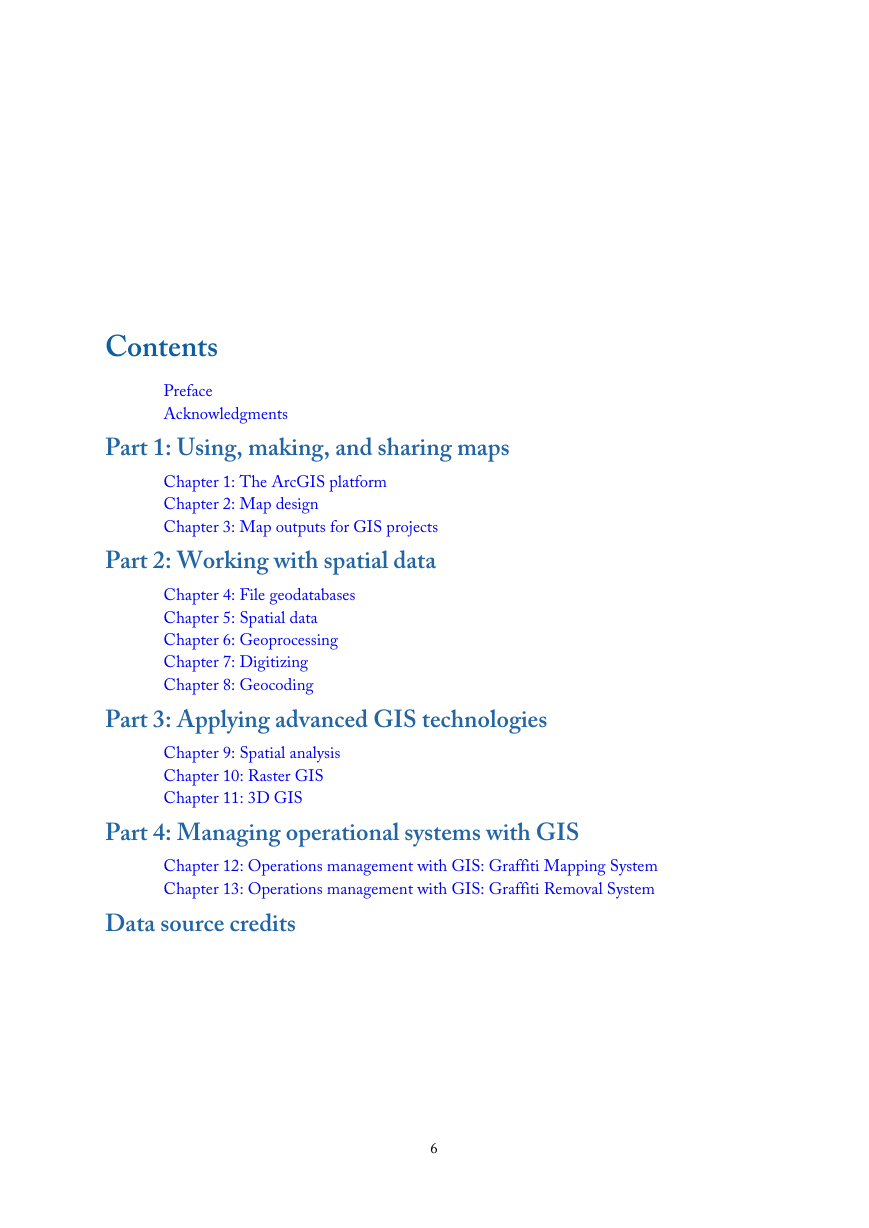
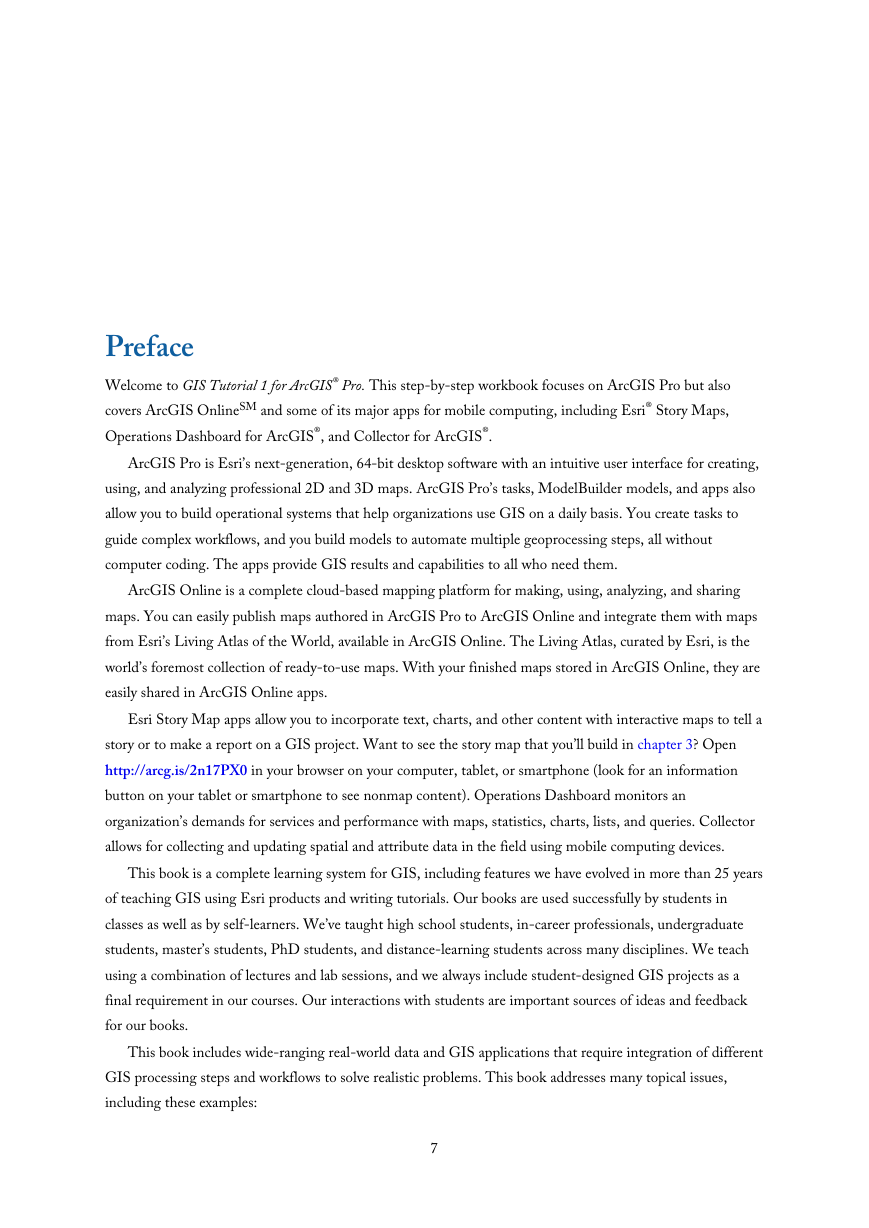
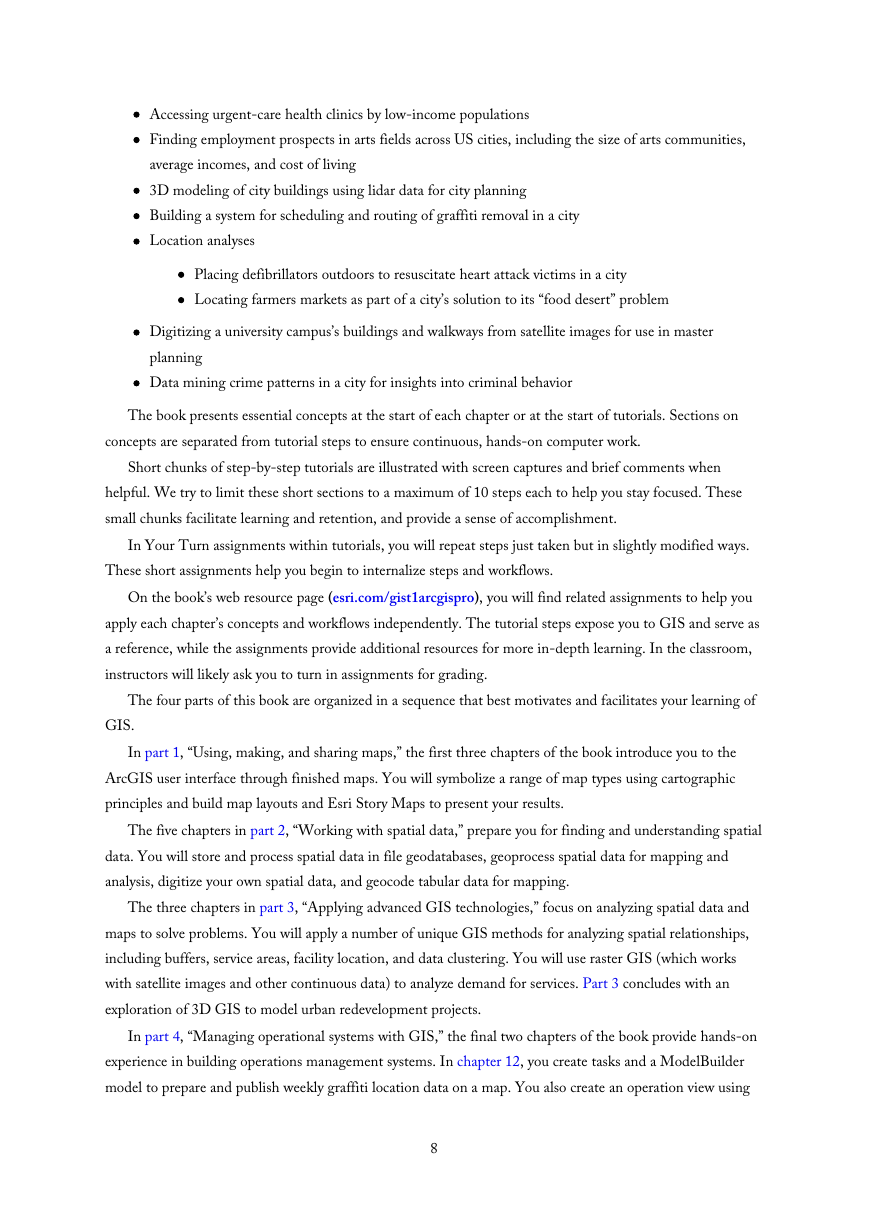








 2023年江西萍乡中考道德与法治真题及答案.doc
2023年江西萍乡中考道德与法治真题及答案.doc 2012年重庆南川中考生物真题及答案.doc
2012年重庆南川中考生物真题及答案.doc 2013年江西师范大学地理学综合及文艺理论基础考研真题.doc
2013年江西师范大学地理学综合及文艺理论基础考研真题.doc 2020年四川甘孜小升初语文真题及答案I卷.doc
2020年四川甘孜小升初语文真题及答案I卷.doc 2020年注册岩土工程师专业基础考试真题及答案.doc
2020年注册岩土工程师专业基础考试真题及答案.doc 2023-2024学年福建省厦门市九年级上学期数学月考试题及答案.doc
2023-2024学年福建省厦门市九年级上学期数学月考试题及答案.doc 2021-2022学年辽宁省沈阳市大东区九年级上学期语文期末试题及答案.doc
2021-2022学年辽宁省沈阳市大东区九年级上学期语文期末试题及答案.doc 2022-2023学年北京东城区初三第一学期物理期末试卷及答案.doc
2022-2023学年北京东城区初三第一学期物理期末试卷及答案.doc 2018上半年江西教师资格初中地理学科知识与教学能力真题及答案.doc
2018上半年江西教师资格初中地理学科知识与教学能力真题及答案.doc 2012年河北国家公务员申论考试真题及答案-省级.doc
2012年河北国家公务员申论考试真题及答案-省级.doc 2020-2021学年江苏省扬州市江都区邵樊片九年级上学期数学第一次质量检测试题及答案.doc
2020-2021学年江苏省扬州市江都区邵樊片九年级上学期数学第一次质量检测试题及答案.doc 2022下半年黑龙江教师资格证中学综合素质真题及答案.doc
2022下半年黑龙江教师资格证中学综合素质真题及答案.doc